7 Steps to a Comprehensive Backlink Audit
Discover all links to your site & get rid of the ones that are hurting your rankings
Backlinks are one of the most important ranking factors to search engines. And it's a pretty simple idea: the more reliable, relevant resources link to a page, the more useful and valuable that page must be (and the higher rankings it deserves). Similarly, 'bad' backlinks are links from spammy or irrelevant sources that probably appeared from old negative SEO techniques you don't even remember of. Such links are treated as indicators of poor quality, diminishing the page's value and authority in search engines' eyes and often resulting in ranking penalties.
This is why evaluating the status quo and auditing your site's backlink profile is the first off-page step to take. It's crucial that you do backlink analysis before you even consider a link building campaign — this way you'll be able to eliminate all links that may threaten your rankings, and then start clean with building fresh, high-quality links. Here is our complete guide to quick and easy link profile audit.

Step 1: Get the most complete list of your backlinks
To run a comprehensive and accurate backlink audit, you should definitely start with getting a complete list of web pages that presently link to your site.
How-to: Find backlinks with SEO SpyGlass. Run SEO SpyGlass backlink audit tool, enter your website's URL, and let the software collect all your backlinks.
Tips: 1. Pull backlinks from Google Search Console and Google Analytics. By default, SEO PowerSuite Link Explorer is used to collect backlinks — it's our inhouse link index that's updated non-stop, in real time. For an even more comprehensive backlink picture, you may want to use all 3 backlink sources integrated into SEO SpyGlass. To do this, go to Preferences > Google Analytics Account and enter your account credentials. To pull backlink data from Search Console, go to Preferences > Google Search Console Account.
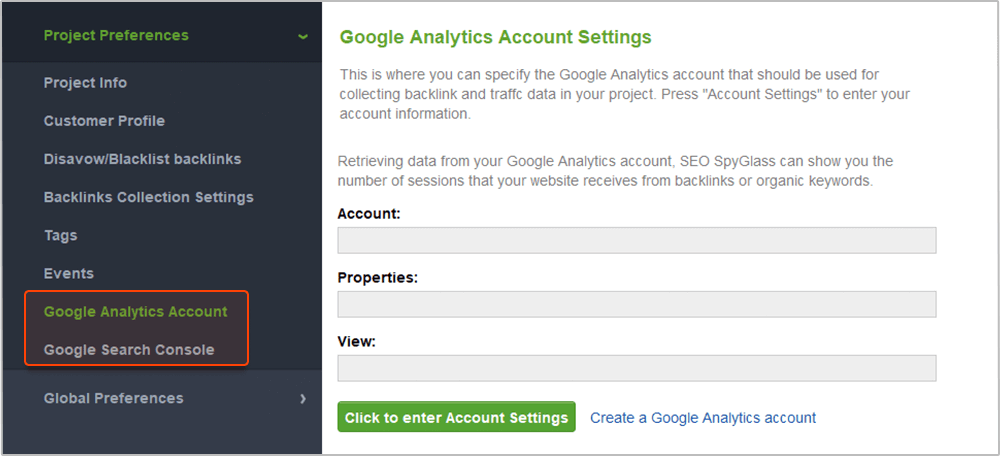
2. Check if all the links are still in place. It's not always possible for link indexes to keep up with all the changes on the Web, and some backlinks that no longer exist in reality may still be kept in SEO PowerSuite Link Explorer, Google Analytics, or Google Search Console. Thus, when you analyze your site's backlinks, you may have some non-existent backlinks messing up your stats.
That's where SEO SpyGlass' real-time link checks come in handy. To check your backlinks in real time, go to
Backlink Profile > Backlinks, select the backlinks in your workspace, and hit
![]() to
update backlink page data. Check only the Backlink Page Info box and hang on a little while your link
data is being refreshed. When the backlink audit is complete, examine the Links Back column: it will
show whether each link is indeed found on the page with either dofollow tag or nofollow tag attribute. If the
link or the linking page has been removed, you will see the link missing or page not found
value.
to
update backlink page data. Check only the Backlink Page Info box and hang on a little while your link
data is being refreshed. When the backlink audit is complete, examine the Links Back column: it will
show whether each link is indeed found on the page with either dofollow tag or nofollow tag attribute. If the
link or the linking page has been removed, you will see the link missing or page not found
value.

Once you've found such non-existent links, you can safely remove them from the project completely (right-click the link and hit Remove backlinks from project) to make sure you aren't wasting your time on analyzing links that no longer exist.
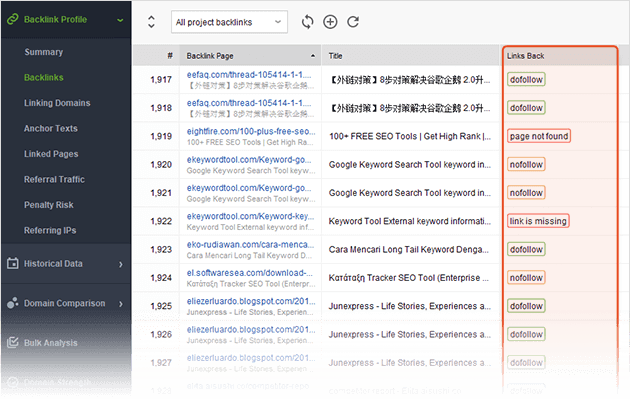
Step 2: Assess your backlink profile as a whole
A link profile is made up of individual links — but before you look into the details of each of your links individually, you need to understand how they are performing together, and identify the core strengths and weaknesses of your link profile as a whole. You can do that in the Summary section of the Backlink Profile module in SEO SpyGlass. Here, you'll find your total number of backlinks and a wealth of important stats on them.
How-to: 1. Compare your Total Links vs. Linking Domains. The total number of backlinks your site has is a good starting point in understanding how strong your backlink profile is. Yet multiple links coming from one and the same domain are considered to have lower value, so unique linking domains are typically a more reliable metric than link count.
Your link profile will obviously have considerably more total links than linking domains, but your aim is to have as even a ratio as possible.

2. Check the dofollow vs nofollow ratio. While it's true that nofollow links do not have SEO weight, a natural link profile can't consist of dofollow links only, so your best option is to have a natural mix of nofollow and dofollow links.
If nofollow links prevail in your backlink profile, it's a signal to rethink your link-building strategy and try to focus on acquiring more SEO-valuable dofollow links.
If there aren't any nofollow links in your profile, this may be a flag that your links were acquired in an unnatural manner and you need to further investigate your profile for other traces of spammy techniques.
3. Assess your link profile growth over time. Go through the Live Backlinks History to get an overview of how your backlink profile changed over time. Review the backlink history to see if your site's number of backlinks has been growing. Look for spikes to figure out which of your marketing activities (content, campaigns, etc.) have been especially successful in attracting links.

4. See the SEO strength of your backlink profile. The audit tool compiles a brief overview report into the PageRank and the authority of the referring domains. InLink Rank is a metric to estimate the authority of the page or of the domain according to a number of search engine ranking criteria. This metric is crucial to consider in your link building strategy to secure your site against link penalties.
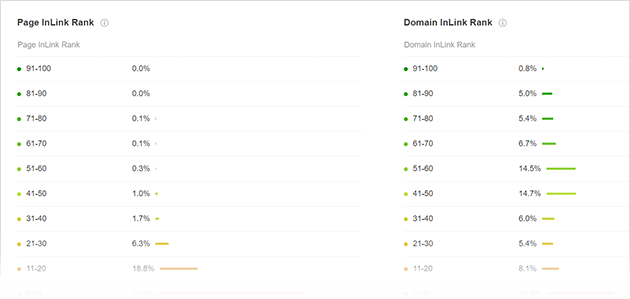
5. Analyze how many backlinks are coming from homepages. As the homepage is the most authoritative page of a website, links appearing there can be easily deemed as paid links — especially if their number is excessive.
If links from homepages considerably exceed links from internal pages in your link profile, pay extra attention to these links and make sure they were built naturally.

6. Check backlink countries. When it comes to backlink countries, just like with other aspects of link profile audit, you should keep in mind your links' diversity. Yet the rule of a thumb is that if you optimize your website for a specific geo-location, your aim is to get maximum location-relevant backlinks.
Say, if you're a UK-based business that targets a local market, but most of your links are coming from USA-based websites, it's high time for you to switch to getting good backlinks from local sites.

7. Check top anchor texts and keywords. Irrelevant anchor text, keyword stuffing, or too many identical anchors can get you in trouble with search engines and cause a ranking drop.
If your obvious anchor text leaders are commercial anchors with lots of money keywords, it's high time to start an anchor-text diversification campaign.

Further down, you will see the Anchor texts cloud which is a visual presentation of your anchor text density. The top anchors (often this is a branded anchor of a company), are highlighted in larger fonts and different colors.
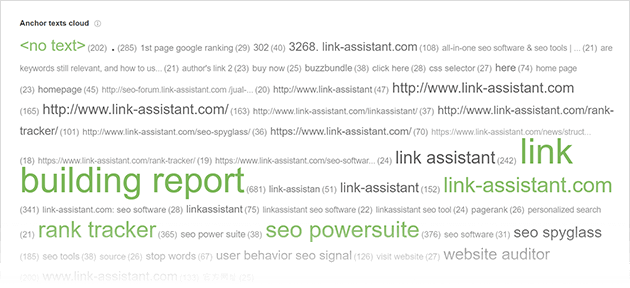
8. Examine the linked-to pages. Most links your site receives will typically point to your homepage — the first level in the structure of your website. However, you need to balance those links by a number of other links going to deep internal pages of the website.
If you have very few links pointing to your internal pages, it may be a good idea to launch a thought-out content marketing campaign that earns more backlinks for your deeper pages.
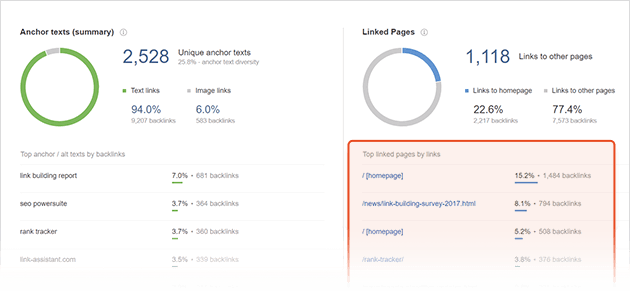
Step 3: See how your links compare to competitors'
The next crucial step in your link profile audit is checking how it compares to your main competitors — to identify your site's strong and weak points and see what will help you outrank your competition.
How-to: Add competitors' sites for comparison. In your SEO SpyGlass project, navigate to the Domain Comparison module and specify the URLs of your top SEO competitors. Voila! The tool analyzes backlinks of your top ranking rivals, comparing them against a bunch of crucial link factors, with a 1 to 5 overall rating assigned to each site.
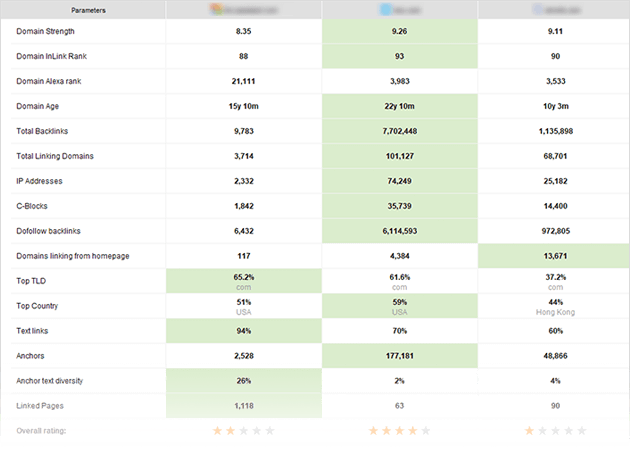
Tips: 1. See where your competitors' links intersect. Looking into the intersection in your competitors' backlink profiles can give you insight into their link strategy — and help spot some valuable link building opportunities for your own site.
To do this, go to the Link Intersection submodule (still under the Domain Comparison module) to see the domains that link to two or more of your competitors but not to you. Such referring domains are your best candidates in terms of link acquisition, as they are relevant to your niche, and pitching a backlink from them will be quite natural.
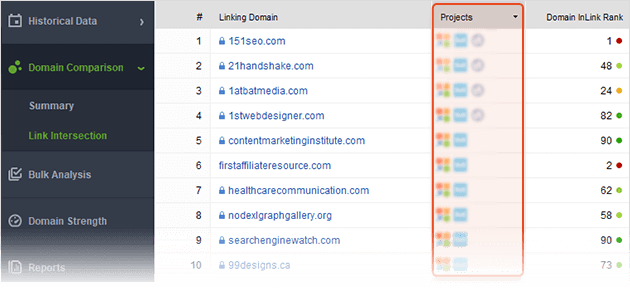
2. Explore competitors' links in-depth. When you were adding competitors to the competitive backlink analysis, SEO SpyGlass created a project for each of them in the background. In the Projects drop-down menu, select a competitor you'd like to look at in detail, and hang on a moment while SEO SpyGlass loads all the data. Switch to the Summary module for an overview of the competitor's link profile. The anchor-related part can be especially useful for ideas on new anchors for your links. Anchor diversity (unique anchors divided by backlink count) is also an important metric to consider — it'll give you a solid idea on how many of your anchors you need to optimize for your target keywords.
Step 4: Pinpoint potentially dangerous backlinks
Now that you've reviewed your link profile as a whole, it's time to spot potentially dangerous links in it that may end up with link penalties. The most convenient way to go about this is to analyze link quality by domain — it is considerably quicker and no less effective. Especially if you have a few thousand links or more, evaluating them by linking domain is going to save you tons of time.
How-to:
Calculate Penalty Risk. In SEO SpyGlass' Backlink Profile
module, switch to the Penalty Risk submodule — here, you'll be able to review and analyze the domains that
link to your
site. Select all referring domains and hit the Update button
![]() to refresh on the Penalty
Risk stats.
to refresh on the Penalty
Risk stats.
Hang on a moment while SEO SpyGlass is checking the domains. When it's done, click on the header of the Penalty Risk column to sort the domains by their riskiness.
Roughly, a link with a 0 to 30% risk value is usually considered safe. A link in the 30 to 70% range may potentially be harmful, so it's recommended that you take a closer look at it. A Penalty Risk of over 70% is considered high and calls for immediate action to prevent link penalties.
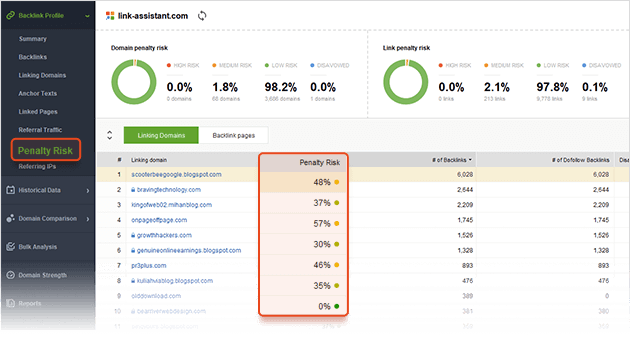
For details on why any one of the domains is considered risky, click the info button next to the domain's Penalty Risk value. This will reveal a list of factors that make links from this domain potentially risky.
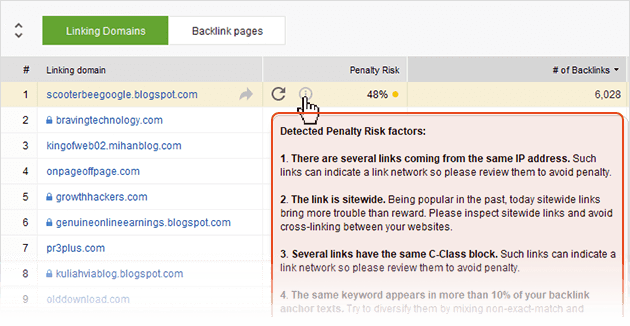
Step 5: Re-check suspicious backlinks manually
It's up to you how "strict" your backlinks cleaning-up will be, but removing lots of backlinks at once may cause a ranking drop, so, not to overdo with link removal, you need to smell-test the suspicious links manually and get rid of your links in the most "glaring" cases only.
How-to:
Examine the risky linking domains. Still in Backlink Profile ->
Linking Domains submodule, in the Linking domains tab, go through the available columns to
double-check all the suspicious links you've found. Select the domains and click the update button
![]() to check if the
domain is relevant to your topic, and if the website itself is trustworthy.
to check if the
domain is relevant to your topic, and if the website itself is trustworthy.
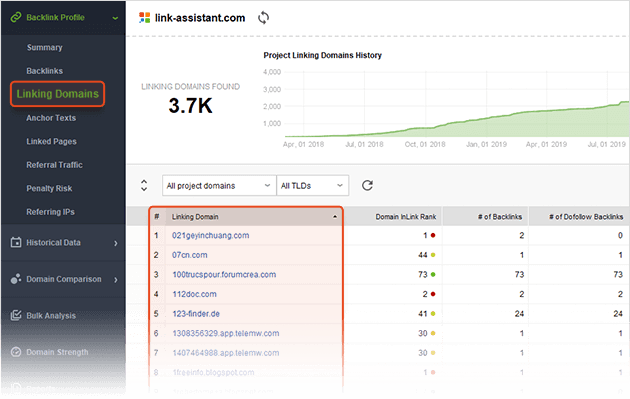
Tips: 1. Check how much traffic each backlink brings. Although not an SEO factor, stats on traffic through backlinks let you see which of your links bring actual visits to your site.
The data on referral traffic is driven from Google Analytics. So, you need to specify your Google Analytics credentials, if you haven't done it at the beginning, and the audit tool will sync with your GA account and gather the traffic stats. You can add the Referral Sessions column by clicking on the Edit visible columns button in the upper right corner of the workspace and quickly see if the backlink pages and referring domains bring you page views. (Alternatively, in your Backlink Profile, switch to the Referral Traffic submodule that will give you a breakdown by referring domains and by backlink pages).
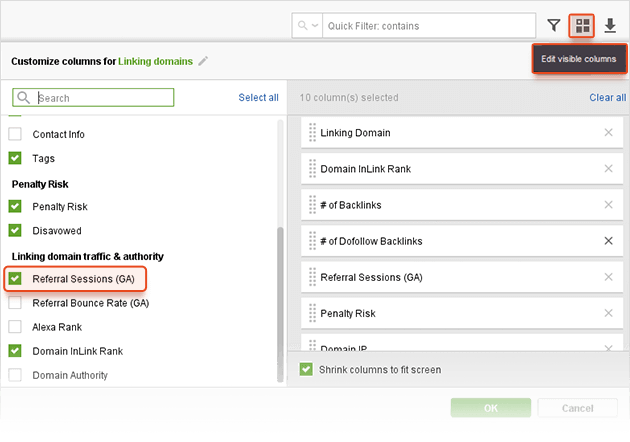
Now, you can see how many visitors each of your backlinks has brought in the last 30 days in the Referral sessions (GA) column.
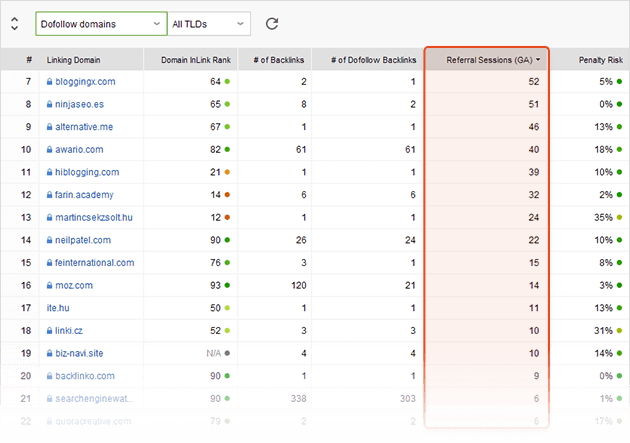
2. Check InLink Rank. This metric, being an alternative to Google's PageRank, shows the value of your backlinks. The higher InLink Rank score means that these links (or domains if you check Domain InLink Rank) are the most valuable in your profile. And a low score helps you to identify low quality, spammy links. If you see that there are such links in your profile, you should consider removing them to stay safe from link penalties.
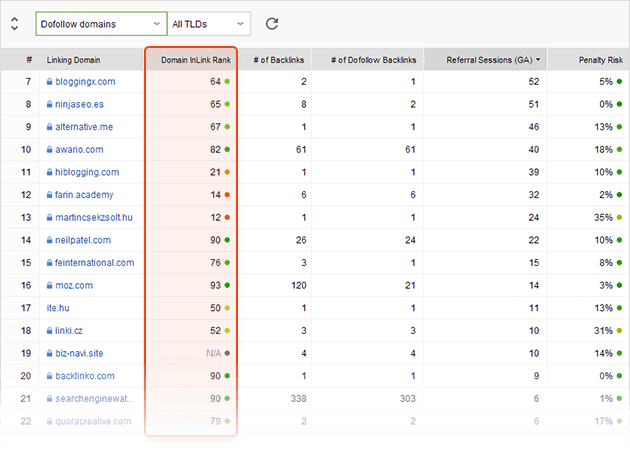
3. Use tags. You may want to tag some of your backlinks at this stage, so that you can quickly sort out all the links that require further action (e.g. if you plan to contact the webmaster to ask for link removal). To tag a backlink, right-click it and choose Add tags to selected record(s).
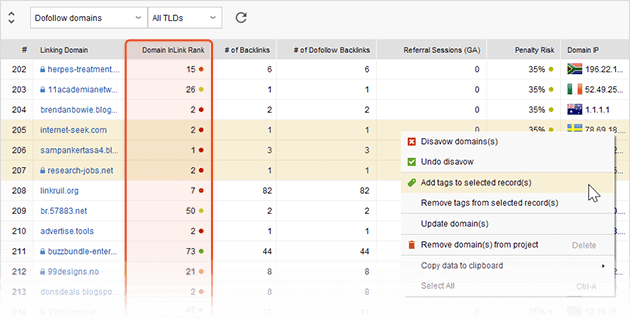
Then, use the filter tag to sieve away the bad links from the rest of non-spammy links.
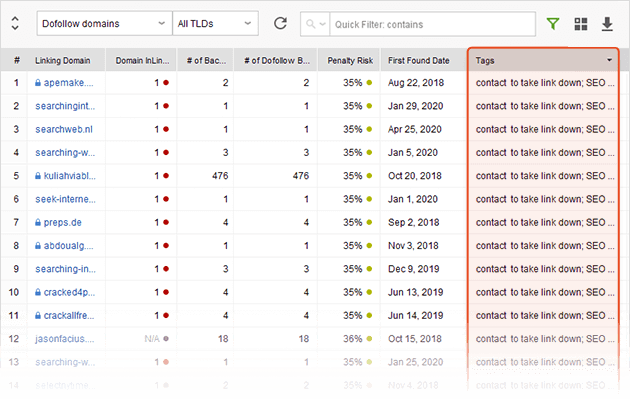
Step 6: Have harmful links taken down
Once you've identified dangerous links in your backlink profile, it's time to get rid of them without waiting for actual link penalties. The most commonly used method of doing that is by contacting the webmasters of sites that link to you, and simply asking them to take the links down.
How-to: 1. Get webmasters' contact details. To save time on digging up contact info manually, you can get webmasters' email addresses right in SEO SpyGlass. To do that, in your SEO SpyGlass workspace, right-click the header of any column to open the workspace editor. Add a Contact Info column to your workspace (by double-clicking it in the list of available columns on the left), and click OK. Now, select the links you'd like to get contact details for, hit the Update button, and select Contact Info to be updated. The column you've just added will now populate with email addresses of webmasters (if available on the website).
2. Reach out to webmasters via email. Copy the email addresses SEO SpyGlass found for you, and send out emails to webmasters. If you only found a couple of spammy links, you can easily do that by composing a personal email for each of the webmasters — but if we're talking about dozens or hundreds of harmful backlinks, you may want to create an email template requesting link removal. In either case, make sure you introduce yourself in your email, mention your position (e.g. SEO or site owner), explain that you are trying to prevent (or recover from) a search engine penalty and would appreciate it if the link was removed, specifying the URL of the page you found the link on.
Step 7: Disavow spammy backlinks you're unable to remove
If you have a large number of spammy links to your site, or if you don't hear back from the webmasters you contacted asking to remove the links, you can tell Google to ignore these links by disavowing them. You can easily generate a disavow file right in SEO SpyGlass.
How-to: 1. Add links to the disavow list. In your SEO SpyGlass project, select the backlinks you'd like to disavow. Right-click the selection, and hit Disavow backlinks.
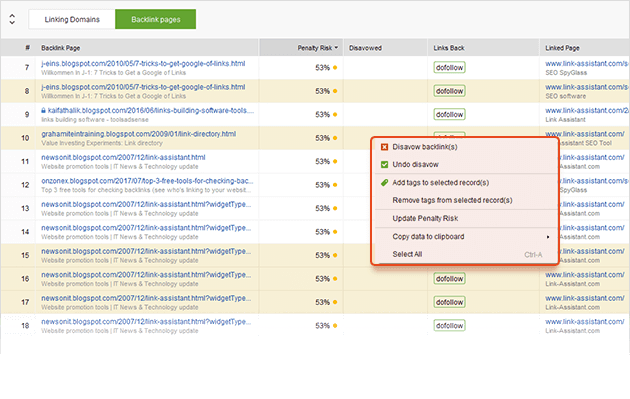
2. Decide if you're disavowing the spammy backlink only or the whole referring domain, and add comments. In the menu that pops up, choose whether you'll only be disavowing the backlink page you just added (Backlink), or the whole domain that links to your site (Entire Domain). At this step, you can also add a comment to the records you're disavowing. Comments are useful for your own future reference - whenever you review or edit your disavow file later, you'll instantly see what kind of referring domains you were disavowing and why.
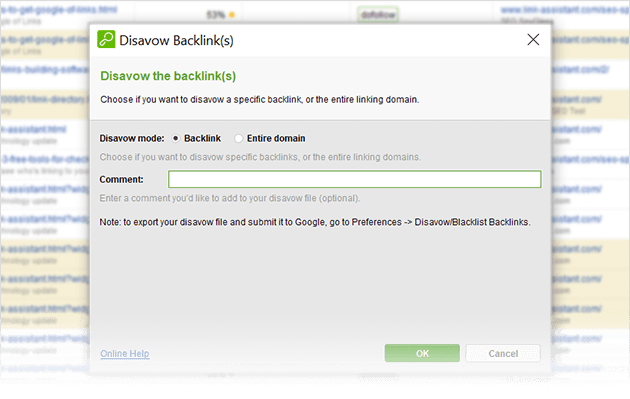
3. Export your disavow file. After you've added all links you're about to disavow to the list, go to Preferences -> Disavow/Blacklist Backlinks. At this stage, you can edit the comments by double-clicking any comment to make changes. Clicking Add lets you add links to your disavow links, and clicking Remove deletes selected records from the list. In the Choose the action menu, you can select whether you'd like to simply disavow the backlinks, disavow and exclude them from all future updates you make in the project, or disavow and blacklist the links (have them removed from the project completely).
Once you're happy with your disavow list, hit the Export button and select the folder to save the file in so that you can upload it to Google Webmaster Tools.
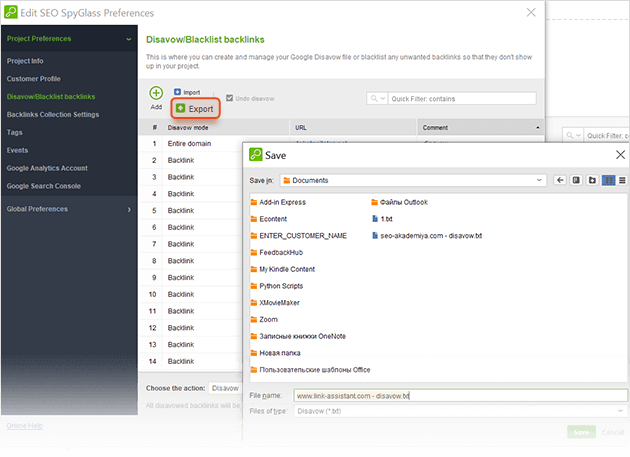
4. Upload your disavow file to Google. In the Google Disavow Tool, select your website and upload the disavow file you generated. That's it — you've told Google which of your backlinks to ignore, and your site is all set to start clean!
Tip: Mind that every new disavow file you upload to Google will override the previous one. If you've already submitted a disavow file for your site, make sure your new file includes the previously disavowed links in addition to the ones you're disavowing for the first time.
Advanced SEO tips for a complete link audit.
Diversifying anchors
Link anchors is something you should have in mind in your future link building strategy. Switch to the Anchor Texts module to have an in-depth review of your anchor phrases. Use the drop-down arrow to filter text links and image links. Look through the Anchor Text column. Once you find a spammy anchor or an empty text link, check the details in the Backlinks column. See if you can request from the referring domains to remove or alternate the surrounding link text.
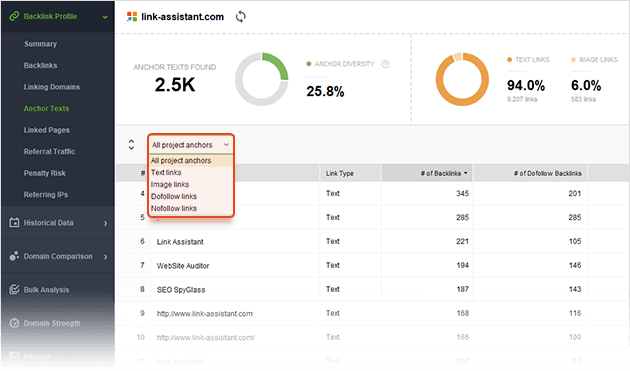
Fixing dead backlinks
For fixing dead backlinks, go to the Backlinks report and review the Linked Page Status Code. Pay attention to Page Not Found value. If there are any domains linking with dofollow tags to 404 pages, create such pages for the available link or redirect such URLs to other relevant pages.
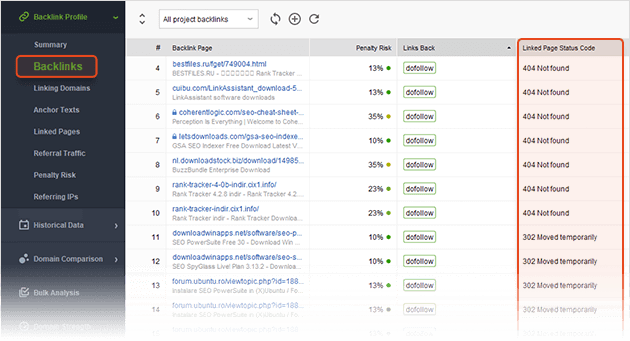
Alternatively, switch to the Linked Pages module and filter the pages by Linked Page Status Code to get the overview report for all your broken links. Pay attention to linked pages with the largest number of dofollow backlinks and referring domains. Fixing dead backlinks is a surefire way to accumulate more link juice by a simple and timely link profile audit.
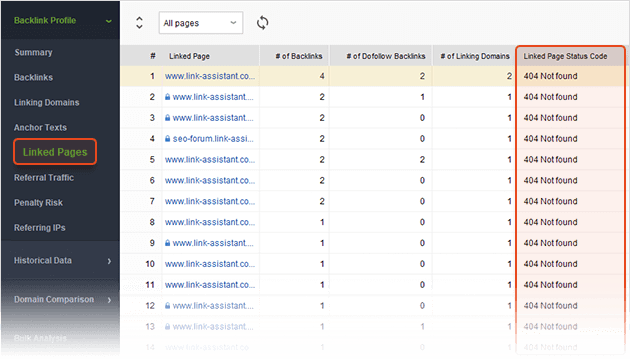
Monitor backlinks regularly not to overlook an SEO attack
Sometimes, intruders resort to negative SEO practices to hurt someone's rankings. If you feel there's a high probability for an SEO attack, consider auditing your backlinks regularly. For a professional link profile audit, SEO SpyGLass link auditor allows scheduling tasks and alerts.
Go to Preferences > Scheduler & Alerts, click to Add a task, and select the task type as Update backlink data. Following the wizard, define the type of backlink data to be updated, frequency of backlink checkups and the delivery method.
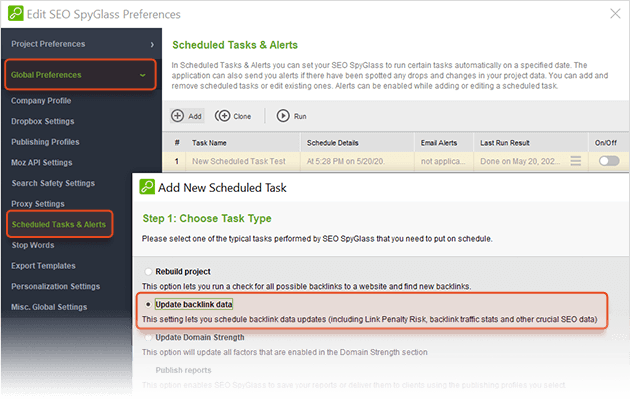
For example, you can define an alert for too many new backlinks coming from one or only a few referring domains (which is a signal of negative SEO link-building). You will be alerted about a sharp increase in backlinks, and you will have time to review them and disavow before link penalties hurt your rankings.
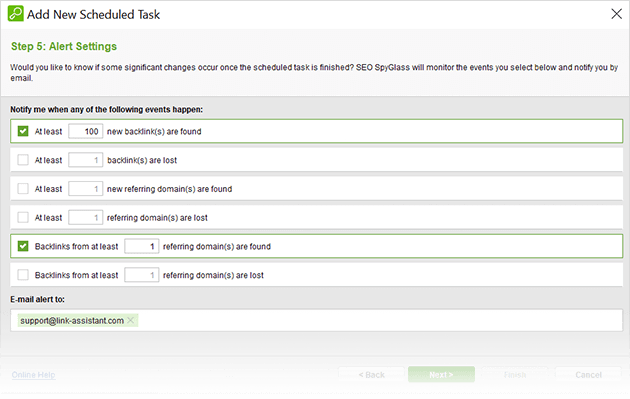
Your link profile is all clean and shiny!
Now that you are done with backlink audit and free from spammy links, you've got a clean link profile to start working on. It's time to start building relevant, high-quality backlinks to win search engine's trust and respect.


